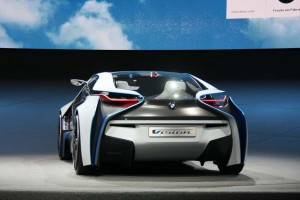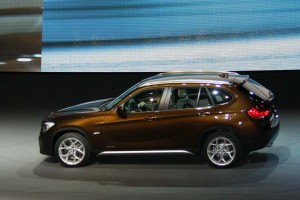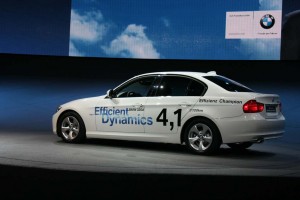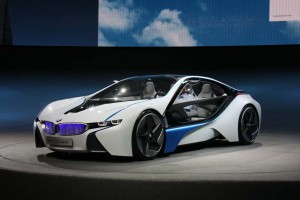
The Vision Concept is designed to show you can deliver great performance and equally solid fuel efficiency, here using a diesel-hybrid powertrain. No production is planned.
BMW often goes to great lengths to prove a point – especially when it wants to convince the media that it really does have some of the greenest cars in the luxury segment. The automaker devoted virtually its entire news conference, at the 2009 Frankfurt Motor Show, to unveiling various new Efficient Dynamic models large and small.
The term is a sort of catch-all for various clean, high-mileage technologies, from downsized diesels to hydrogen cars. And nearly every possible form of “green” powertrain was on display.
But the star of the stand was clearly the 2010 BMW Vision Concept we analyzed before, a prototype diesel-hybrid designed to show that you don’t have to abandon the performance the German maker is known for in order to get truly spectacular mileage.
The heart of the Vision is a 3-cylinder turbo diesel paired with two separate electric motors, one on each wheel – which effectively gives the Vision all-wheel-drive.
The show car’s energy management system not only adapts to real-time demands but can actually forecast likely needs. For example, it might predict that a driver is getting onto the freeway, and shift engine cooling modes.
The strikingly unusual Vision show car can launch from 0 to 100 kmh (0 to 62.5 mph) in just 4.0 seconds, with a top speed of 250 kmh, or 155 mph. Even so, it yields more than 65 mpg, using the European Union’s testing cycle, and puts out only 99 grams of CO2 when running on gasoline. It can also run, for very short distances, on battery power.
The 2010 BMW Vision concept “proves individual mobility has a future,” said technology chief Klaus Draeger.
Along with the Vision Concept, the Bavarians rolled out their new 2010 BMW X1, the smallest model yet of their Sport-Activity Vehicle line. Tech director Draeger described the crossover vehicle as “The ideal solution for customers who don’t want a large car but want the features of an SAV.”
For those who prefer a more conventional body style, BMW debuted the 2010 320d Efficient Dynamics, which, suggested Draeger, “at first might seem like a very normal 3-Series.” But with its lowered body, special, low rolling resistance tires and a compact 2.0-liter common rail diesel engine, it achieves a microcar-like fuel economy of nearly 70 mpg, while carbon dioxide emissions come in at 109 grams per kilometer – well within proposed European Union guidelines.
Even so, the 320d is surprisingly peppy, BMW officials claimed, churning out a solid 163 horsepower, enough to hit 60 in 8.2 seconds, and reach a 137 mph top speed.
To keep the tiny diesel from shaking the 3-Series sedan apart, BMW engineers added a Centrifugal Pendulum Absorber and a dual-mass flywheel.
There are no plans to bring the $44,000 2010 BMW 320d to the U.S.
Slow to enter the hybrid segment, BMW is seeking to make up lost time with a series of new offerings, including the Active Hybrid X6, which yields about a 20% mileage improvement over a comparable, gas-only X6 crossover.
Then there’s the Active Hybrid 7, which is both fast and efficient, according to Draeger. It gets about 15% better mileage than a 750i sedan, even though it’s faster than the conventionally-equipped model.
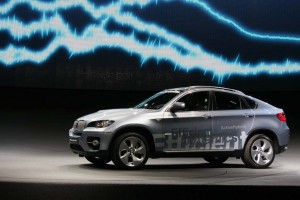
Slow to the party, the Bavarian maker is ramping up HEV production, starting with the 2010 BMW Hybrid X6, then following with the Hybrid 7-Series, which will outperform the 750i - deliver better mileage.
The display of high-mileage might also included the Mini E, a battery car built by the German maker’s British subsidiary – and which is now going through extensive testing in Germany, the U.S., and soon, in France. Mini officials have said that they could put the Mini E into showrooms if they get good feedback from this one-year fleet test.

